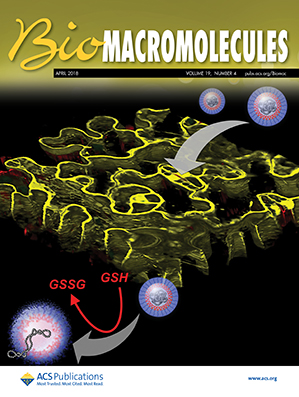Capillary Migration of Peptide Nanowires for Surface Strengthening
IF 5.4
2区 化学
Q1 BIOCHEMISTRY & MOLECULAR BIOLOGY
引用次数: 0
Abstract
This study explores the capillarity-guided self-assembly of cyclo-diphenylalanine (FF) nanowires on surface defects with engineered topographies, emphasizing the interplay between geometric confinement and evaporation-driven flow. Evaporation on v-groove and trench substrates induces directional migration and alignment of FF nanowires, forming ordered, surface-adherent structures. Numerical simulations support these observations by illustrating flow behavior and deposition patterns. Guided by this mechanism, we fabricated nanowire-reinforced polyvinyl alcohol (PVOH) composite fibers with high stiffness (20.29 ± 6.57 GPa) and tensile strength (581.7 ± 34.69 MPa) at 10 wt % loading. Thermally treated, physically damaged fibers exhibited autonomous healing without external agents. Capillary migration and nanowire reassembly at fracture interfaces restored continuity and improved ductility, reflecting dynamic nanowire organization. These results present a geometric strategy for nanowire alignment and demonstrate the dual function of peptide nanowires in mechanical reinforcement and self-repair, highlighting their potential as active components in bioinspired, damage-tolerant materials.
- Download: Download high-res image (123KB)
- Download: Download full-size image
肽纳米线表面强化的毛细管迁移研究。
本研究探讨了环二苯丙氨酸(FF)纳米线在工程形貌表面缺陷上的毛细管引导自组装,强调了几何约束与蒸发驱动流动之间的相互作用。v型槽和沟槽衬底上的蒸发诱导FF纳米线的定向迁移和排列,形成有序的表面粘附结构。数值模拟通过说明流动行为和沉积模式来支持这些观察结果。在此机制的指导下,我们制备了具有高刚度(20.29±6.57 GPa)和抗拉强度(581.7±34.69 MPa)的纳米线增强聚烯烃(PVOH)复合纤维。经过热处理,物理损伤的纤维在没有外力作用的情况下表现出自主愈合。断裂界面处的毛细迁移和纳米线重组恢复了连续性,提高了延展性,反映了纳米线的动态组织。这些结果提出了一种纳米线对齐的几何策略,并证明了肽纳米线在机械增强和自我修复方面的双重功能,突出了它们作为生物启发、耐损伤材料的活性成分的潜力。
本文章由计算机程序翻译,如有差异,请以英文原文为准。
求助全文
约1分钟内获得全文
求助全文
来源期刊

Biomacromolecules
化学-高分子科学
CiteScore
10.60
自引率
4.80%
发文量
417
审稿时长
1.6 months
期刊介绍:
Biomacromolecules is a leading forum for the dissemination of cutting-edge research at the interface of polymer science and biology. Submissions to Biomacromolecules should contain strong elements of innovation in terms of macromolecular design, synthesis and characterization, or in the application of polymer materials to biology and medicine.
Topics covered by Biomacromolecules include, but are not exclusively limited to: sustainable polymers, polymers based on natural and renewable resources, degradable polymers, polymer conjugates, polymeric drugs, polymers in biocatalysis, biomacromolecular assembly, biomimetic polymers, polymer-biomineral hybrids, biomimetic-polymer processing, polymer recycling, bioactive polymer surfaces, original polymer design for biomedical applications such as immunotherapy, drug delivery, gene delivery, antimicrobial applications, diagnostic imaging and biosensing, polymers in tissue engineering and regenerative medicine, polymeric scaffolds and hydrogels for cell culture and delivery.
 求助内容:
求助内容: 应助结果提醒方式:
应助结果提醒方式:


